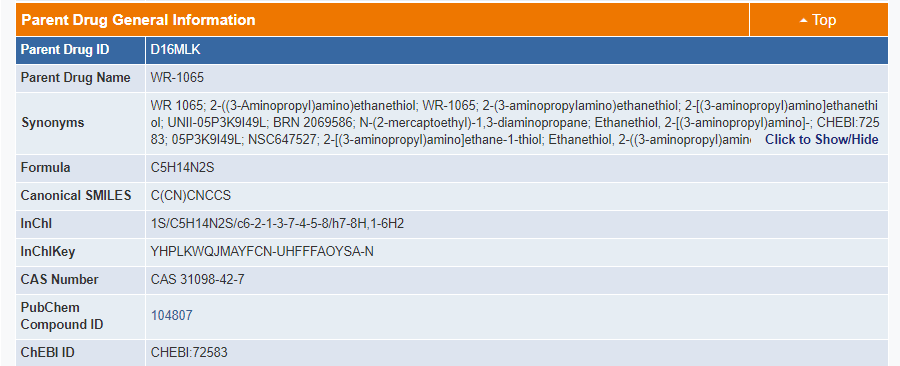(a) Search for targets
In the field of "Search for targets", user can find target entries by searching target name, drug name, disease name and so on among the entire textual component of TTD. Target information can be accessed via crosslink to UniProtKB, PDB, KEGG, OMID and Brenda databases from the following search field. Related target or drug entries can be recursively searched by clicking a disease or drug name.
Queries can be submitted by entering keywords into the main searching frame. User can specify part or full target name, drug name, or any other target related information in the text field. Moreover, user can search by put target, drug or other information together into the text field (separated by space or tab) for narrowing the output results. In order to facilitate a more customized input query, the wild characters of "*" and "?" are also supported.
(1). If search: "Alpha receptor", finds entries with targets names including "Alpha adrenergic receptor" or "Alpha platelet-derived growth factor receptor" etc;
(2). If search: "Oseltamivir Influenza", finds only entry with targets name "Neuraminidase";
(3). If search: "Adrenergic receptor", finds entries with target names including "adrenergic receptor" such as "Alpha adrenergic receptor" or "Beta adrenergic receptor" etc;
(4). If search: "Alpha-1? adrenergic receptor", finds entries with target names like "Alpha-1A adrenergic receptor", "Alpha-1B adrenergic receptor" or "Alpha-1C adrenergic receptor" etc. Here, "?" represents any one character;
(5). If search: "Alpha-* adrenergic receptor", finds the same entries as above. Here "*" represents a string of any length. In this case, it represents "1A", "1B" or "1C" respectively.
(b) Search for drugs
In the field of "Search for drugs", user can find drug entries by searching drug name, disease name, target name and so on among the entire textual component of TTD. Drug information can be accessed via crosslink to PubChem, DrugBank, SuperDrug and ChEBI from the following search field. Related target or drug entries can be recursively searched by clicking a disease or drug name.
Queries can be submitted by entering keywords into the main searching frame. User can specify part or full target name, drug name, or any other target related information in the text field. Moreover, user can search by put target, drug or other information together into the text field (separated by space or tab) for narrowing the output results. In order to facilitate a more customized input query, the wild characters of "*" and "?" are also supported.
(1). If search: "Alpha receptor", finds entries with targets names including "Alpha adrenergic receptor" or "Alpha platelet-derived growth factor receptor" etc;
(2). If search: "Oseltamivir Influenza", finds only entry with targets name "Neuraminidase";
(3). If search: "Adrenergic receptor", finds entries with target names including "adrenergic receptor" such as "Alpha adrenergic receptor" or "Beta adrenergic receptor" etc;
(4). If search: "Alpha-1? adrenergic receptor", finds entries with target names like "Alpha-1A adrenergic receptor", "Alpha-1B adrenergic receptor" or "Alpha-1C adrenergic receptor" etc. Here, "?" represents any one character;
(5). If search: "Alpha-* adrenergic receptor", finds the same entries as above. Here "*" represents a string of any length. In this case, it represents "1A", "1B" or "1C" respectively.
(c) Search drugs and targets by disease or ICD identifier
In this field, users can search TTD target and drug entries related to a specific disease or an ICD-9-CM or ICD-10-CM code. There is a need to enable data retrieval by using the widely used International Classification of Diseases (ICD) codes for facilitating broader, more convenient and automatic data access, processing and exchange by the bench-to-clinic communities, particularly non-domain experts. ICD has been developed by the World Health Organization (WHO), sponsored by the United Nations, adopted by >110 countries and used by physicians, researchers, nurses, health workers, health information managers, policy makers, insurers and health program managers for defining and studying diseases, monitoring and managing health care and allocating resources. ICD codes have been regularly revised to the current version ICD-10. But the previous version ICD-9 is still used by some organizations while proceeding with the transition to ICD-10. In TTD, users can search TTD target and drug entries by inputting a specific disease name to or selecting a certain ICD code from the following search field.
For example: if search "Alzheimer's disease" or "ICD9:331"or "ICD10:G30", users can access to relevant targets and drugs information with this disease or ICD code.
(d) Search for biomarkers
The TTD biomarker entries can be searched by selecting a disease name and ICD code and search other biomarker related information from the following search field.
Biomarkers have been developed as non-invasive tests for early detection and indication of disease risks, monitoring of disease progression and recurrence and classification of disease subtypes and patient subpopulations for providing the most appropriate treatments. As many therapies have been found to elicit markedly different clinical responses in individual patients, there is a particular need for more biomarkers capable of predicting drug response in individual patients, which has led to intensive efforts in the discovery of such biomarkers. Table 2 gives examples of the approved and clinically tested biomarkers for facilitating the prescription of a particular drug to specific patient subpopulation. Moreover, there are considerable interests in adopting the multi-marker strategy for parallel evaluation of multiple existing and novel biomarkers in the diagnosis and prognostics of diseases and treatment responses in individual patients. These efforts may be facilitated by significantly expanding biomarker coverage in the biomarker databases. We, therefore, searched literature reported biomarkers, mapped them to the ICD-9-CM and ICD-10-CM codes and added the relevant information and ICD code search tools in TTD. /p>
Overall we collected 1755 biomarkers for 365 disease conditions, which include both process biomarkers (genetic mutations or alterations, gene amplification and levels of proteins, gene expression, microRNAs, small molecules, or metabolites that capture a molecular/biochemical aspect of disease pathogenesis and the biological responses to the disease process and/or treatment) and global biomarkers (such as tumor sizes, brain structures in neurodegeneration and shape of cells in anemia). Based on the literature descriptions, our collected biomarkers were classified into one or more of the 12 classes.
(e) Search for drug scaffolds
Users can search the TTD drug and target entries related to a drug scaffold by selecting from the list of drug scaffold names in the following "Search for drug scaffolds" field.
The approved and clinical trial drugs are composed of a limited number of molecular scaffolds in contrast to the high number of bioactive molecular scaffolds. For instance, many drugs have been derived from individual scaffold groups such as macrocycles, and 12 FDA-approved anticancer kinase inhibitor drugs are grouped into three scaffold groups. Investigation and exploration of these highly privileged drug scaffolds are important for discovering new drug-like scaffolds, molecular analogs and drugs. To support the relevant efforts, we searched the literatures for the molecular scaffolds of the approved and clinical trial drugs or their drug leads. By using the combination of keywords drug name or alternative name, 'scaffold', 'discovery', 'synthesis' to search the PubChem database, we found 210 scaffolds for 714 drugs and drug leads.
(f) Search for target via sequence similarity
Besides traditional keywords search, TTD also supplies target sequence similarity query for searching similar sequences against all therapeutic targets with available sequence information. The similarity degree of those identified targets will be evaluated by BLAST program, and then be displayed onto your web browser. Identified targets are listed out in the order of their E-value (from the smallest to the largest). Similarity targets of an input protein sequence in FASTA format can be searched by using the BLAST sequence alignment tool. Input query sequence should be provided in FASTA format, which is shown in the above query box.
(g) Pathway Affiliation Search
Drug action depends not only on the direct modulation of its target but also on other regulatory factors within the complex biological networks and physiological systems. Advances in systems biology and bioinformatics have revealed some of these mechanisms at the network and physiological levels, which open more opportunities for the development of new polypharmacology strategies to more effectively treat the diseases. These coupled with the knowledge of target affiliated and drug targeted pathways, including those of the clinical trial and investigational drugs as well as those of the approved drugs, is highly useful for facilitating the development of the novel polypharmacology based drug discovery.
A user can search the target affiliated and drug targeted KEGG or PathWhiz or WikiPathways pathway entries by clicking the "Pathway Affiliation Search" field in the TTD homepage, which leads to the TTD pathway affiliation search page wherein the user can conduct the search by inputting a specific drug or target name, or by selecting a particular pathway entry from the lists of KEGG, PathWhiz and WikiPathways pathway entries respectively. The search by a drug or target name leads to a page wherein the user can select to display the target affiliated or the drug targeted KEGG, PathWhiz or WikiPathways pathway entries respectively. In the respective target affiliated or drug targeted pathways page, the user can further select other targets affiliated to or other drugs targeting the same pathway entry.
(h) Search Chemical Structure Based Activity Landscape of Target
In this filed, TTD provides the information on 1,565 targets (444 successful, 469 clinical trial, 163 preclinical/patented and 489 research targets) with chemical structure based activity landscape.
Users can search by target name, disease name and so on in “Search Chemical Structure based Activity Landscape of Target” or by drop-down lists among the entire textual component of TTD. Search result lists all target(s) that are associated with the users’ input and have the information of chemical structure based activity landscape. The Target Info button links to target information page and displays chemical structure based activity landscape of the target.
For example, if you want to know the chemical structure based activity landscape of EGFR, you can search "EGFR" in the "Search Chemical Structure based Activity Landscape of Target " field.

Search result shows that “EGFR” target has the information of chemical structure based activity landscape. The Target Info button links to the detailed target information page of EGFR and displays its chemical structure based activity landscape.

The “Chemical Structure based Activity Landscape of Target” part in “Target Information” page displays the activity landscape of drugs/compounds with activity on EGFR. All drugs/compounds are clustering based on their 2D chemical structure by using Pubchem fingerprint. Drugs are highlighted by different color according to their highest status such as approved and clinical trial. Click the one or more legend(s) can show/hide all the drugs with the corresponding status. And move the mouse over the bar, the information including activity about the corresponding drug will display. To make it more convenient for users, the figure can be opened in a new window and can also be saved to local.

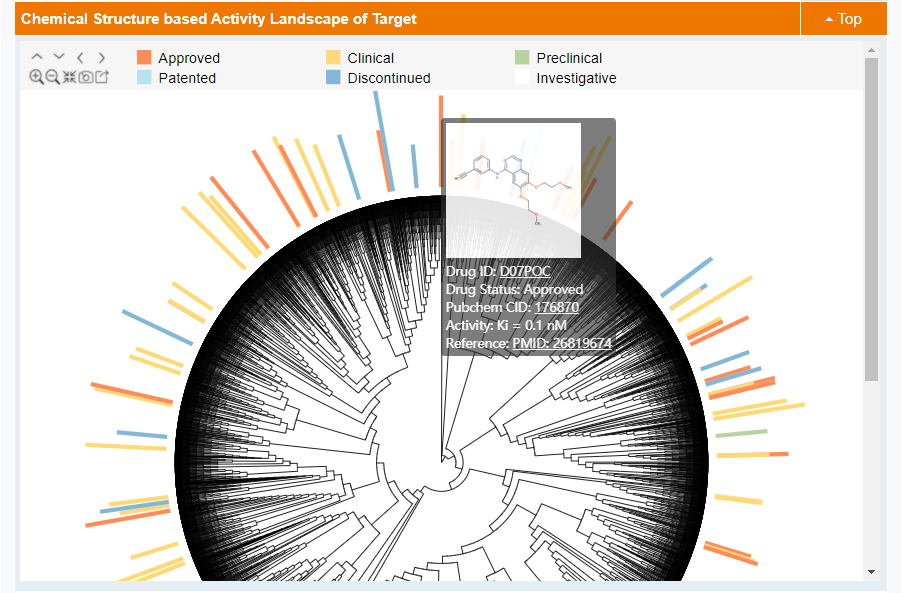
(i) Search Drug Property Profile of Target
In this filed, TTD provides the information on 1,102 targets (435 successful, 356 clinical trial, 125 preclinical/patented and 186 research targets) with drug property profile.
Users can search by target name, disease name and so on in “Search Drug Property Profile of Target” or by drop-down lists among the entire textual component of TTD. Search result lists all target(s) that are associated with the users’ input and have information of drug property profile of target. The Target Info button links to detailed target information page and displays drug property profile of the target.
For example, if you want to know the drug property profile of targets associated with rheumatoid arthritis, you can search “rheumatoid arthritis” in the "Search Drug Property Profile of Target" field.

Search result shows all targets that are associated with “Rheumatoid arthritis” and have the information of drug property profile. The Target Info button links to the target information page with selected target and displays the drug property profile of the target.

The “Drug Property Profile of Target” part in “Target Information” page consists of two section (1) Lipinski RO5-based and (2) six single property (including molecular weight, octanol/water partition coefficient, hydrogen bond donor count, hydrogen bond acceptor count, rotatable bond count, and topological polar surface area) based drug clustering of the target. Drugs are highlighted by different color according to their highest status such as approved and clinical trial in each figure. Click the one or more legend(s) can show/hide all the drugs with the corresponding status. And move the mouse over the heatmap/bar, the corresponding drug property information will display. To make it more convenient for users, the figure can be opened in a new window and can also be saved to local.
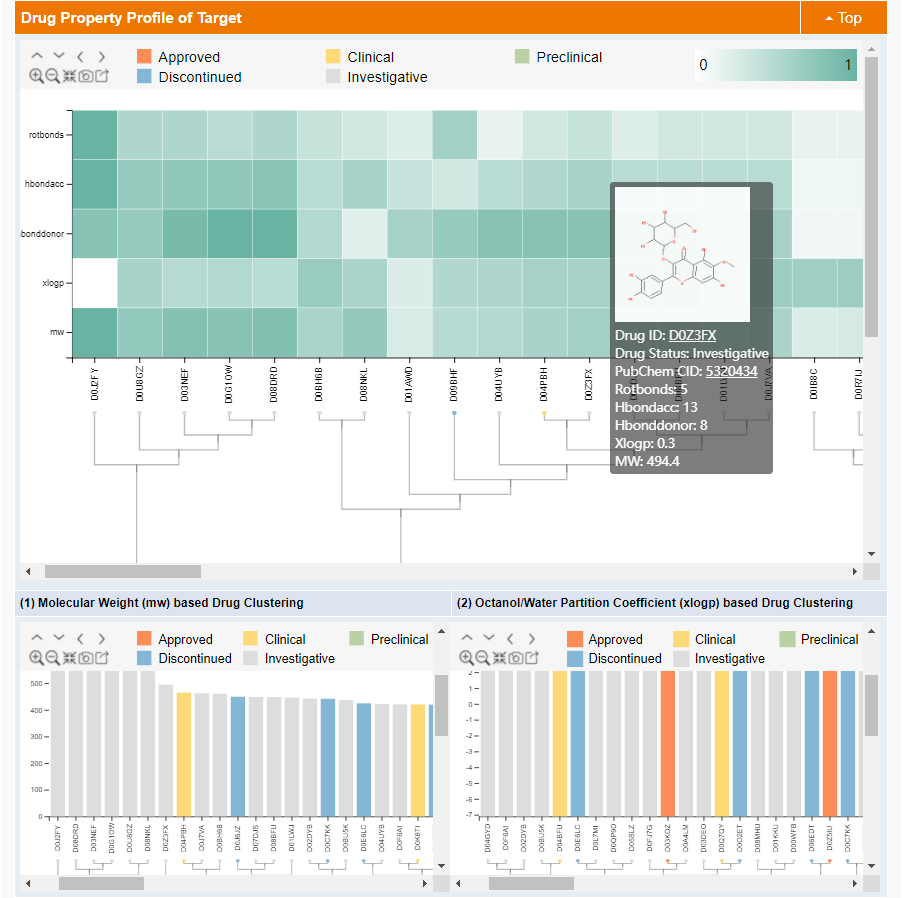
(j) Search Co-Targets of Target
In this filed, TTD provides the information on 672 targets (423 successful and 249 clinical trial targets) with co-targets based on 642 approved and 624 clinical trial drugs.
Users can search by target name, disease name and so on in " Search Co-Targets" field. Users can also search by drop-down lists among the entire textual component of TTD. Search result lists all targets that are associated with the users’ input and have the information of co-targets. The Co-Target Info button links to co-target(s) information that displays co-targets of the target.
For example, if you want to know the co-targets of 5-HT 1A receptor, you can search "5-HT 1A receptor" in the "Search Co-Targets" field.

Search result shows that “5-HT 1A receptor” has the information of co-target. The Co-Target Info button links to the co-target(s) information page of 5-HT 1A receptor.

In Co-Target(s) Information page, Target General information displays Target Synonyms, Target Type, Gene Name, Biochemical Class, and UniProt ID.
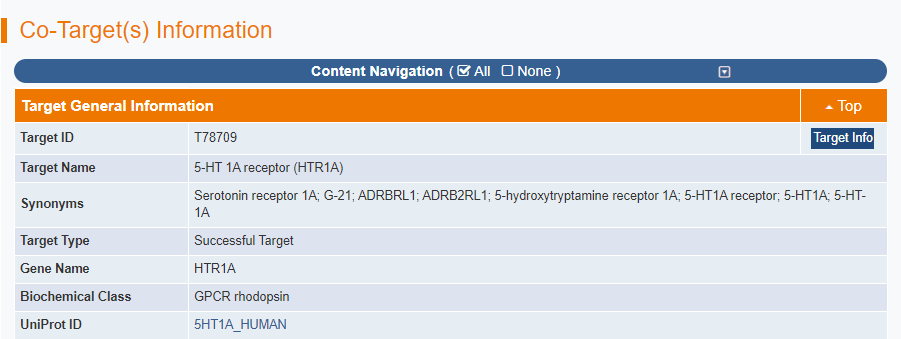
Co-Targets of This Target display the co-targets with co-target name, UniProt ID, gene name, synonyms and its representative drug(s) that modulated the co-targets with 5-HT 1A receptor and its experimental activity value. Moreover, the Click to Show More button can be clicked if this co-target has more than one representative drug(s). Drug Info button links to the detail information page with the drug.
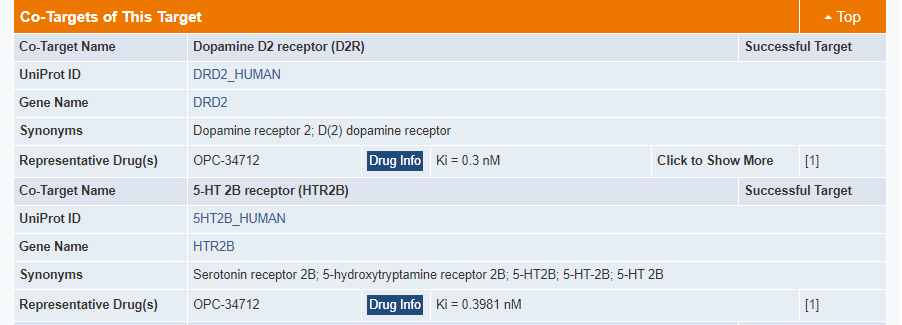
(k) Search Very Weak or Non Binders of Target
In this filed, TTD provides the information on 1,243 targets (383 successful, 392 clinical trial, 137 preclinical/patented and 331 research targets) with very weak binders and 870 targets (309 successful, 275 clinical trial, 91 preclinical/patented and 195 research targets) with non binders.
Users can search by target name, target family, disease name and so on in " Search Co-Targets" field. Users can also search by drop-down lists among the entire textual component of TTD. Search result lists all targets that are associated with the users’ input and have the information of very weak or non binders. The Target Binder Info button links to target very weak or non binder(s) information page.
For example, if you want to know the very weak or non binders of target that belongs to acyltransferase, you can search "Acyltransferase" in the "Search Co-Targets" field.

Search result lists acyltransferases that has the information of very weak or non binders. The Target Binder Info button links to very weak or non binder(s) information page.

In Target Very Weak or Non Binder(s) Information, Target General information displays Target Synonyms, Target Type, Gene Name, Biochemical Class, and UniProt ID.

Very Weak Binders of This Target/Non Binders of This Target displays the very weak binders/non binders with compound name, synonyms, and its experimental activity value on the target. Moreover, the Click to Show/Hide the Information of All Very Weak Binders/Non binders button can be clicked if this target has more than five very weak binders/non binders. Compound Info button links to the detail information page with the compound.

(l) Search prodrugs
In this filed, TTD provides the 534 prodrug-parent drug pair information (146 approved, 79 clinical trial, 9 preclinical and 300 experimental prodrugs).
Users can search by prodrug name, target name, disease name, bioconversion enzyme and so on in "Search Prodrugs" field. Users can also search by drop-down lists among the entire textual component of TTD. Search result lists prodrug(s) that associates with the users’ input. The Prodrug Info button links to detail prodrug information page.
For example, if you want to know the prodrugs that converted by “Alkaline phosphatase”, you can search " Alkaline phosphatase" in the " Search Prodrugs" field.

Search result lists prodrugs that converted by “alkaline phosphatase”. The Prodrug Info button links to Prodrug Information page.
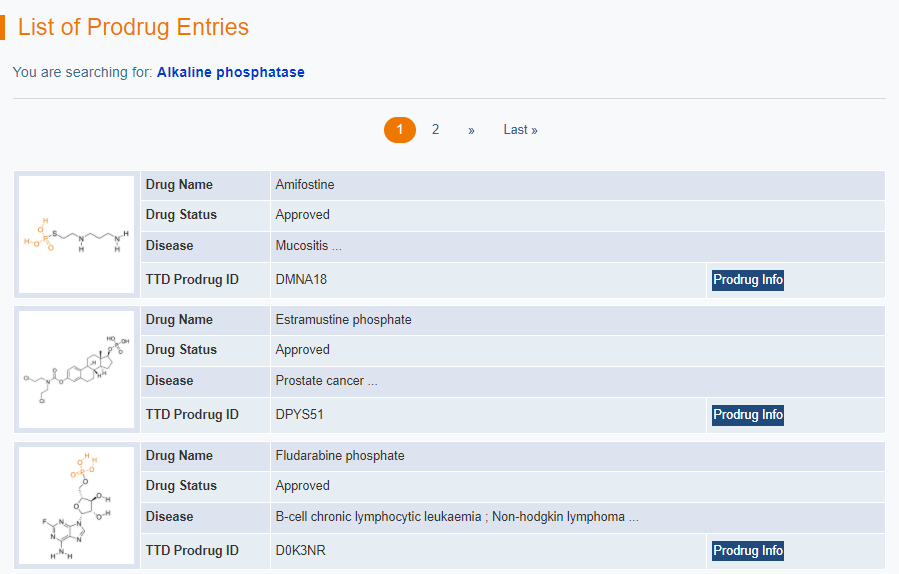
Prodrug General Information displays the structure transformation (png, 2D mol and 3D mol if available) from prodrug to parent drug. Prodrug strategy, bioconversion enzyme and description are also provided for the prodrug-parent drug pairs. Besides, basic chemical information including formula, canonical SMILES, InChI, InChIKey, CAS Number, PubChem compound ID, ChEBI ID is offered.

Parent Drug General Information displays synonyms, Formula, Canonical SMILES, InChI, InChIKey, CAS Number, PubChem Compound ID, ChEBI ID of the parent drug.
